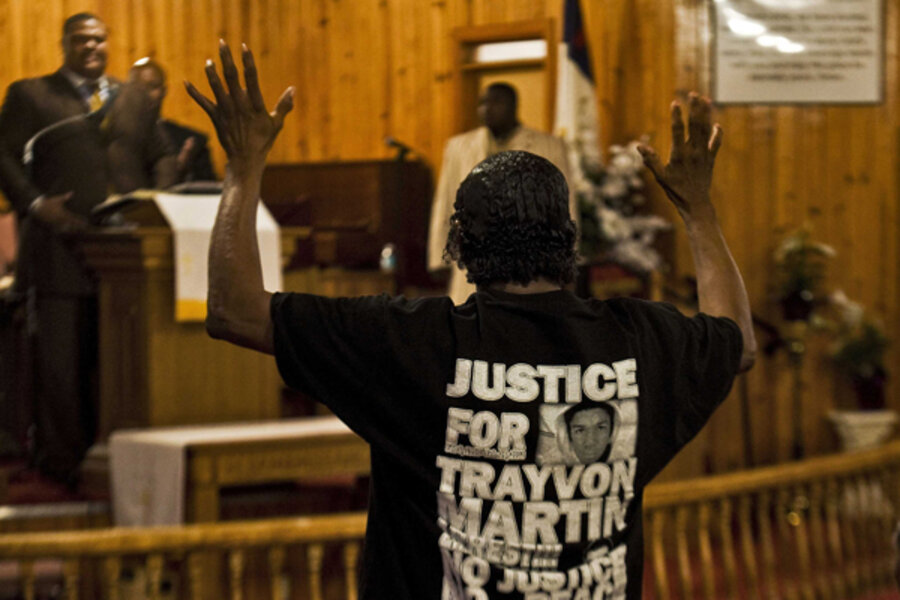Trayvon Martin case: Relief, hope in Sanford, Fla., after Zimmerman charged
Loading...
| Sanford, Fla.
Emotions of grim satisfaction mixed with doses of celebratory approval circulated throughout pockets of Sanford Wednesday evening, as news traveled through town that neighborhood watchman George Zimmerman was in custody and staring down charges of second-degree murder for shooting and killing 17-year-old Trayvon Martin, an unarmed black teenager who was walking home from a convenience store on Feb. 26 when the fateful encounter occurred.
Six tense weeks had elapsed since Trayvon's death, which spurred a national conversation about gun rights and the self-defense laws that were blamed for delaying Mr. Zimmerman's arrest, the history of race relations in the central Florida city where it all took place, and what many saw as the racial profiling of a black teen in a hoodie.
Sitting on a cushioned bench of the W. 13th Street Barbershop in Goldsboro, the historically black part of Sanford, Fla., Lateshia Rollins called up her friend and told her to get to a television. State Attorney Angela Corey in Jacksonville was minutes away from announcing the charges against Zimmerman.
“This ain’t April Fool’s Day. Look on the news!” Ms. Rollins said into her cellphone. She watched on TV as Ms. Corey told the assembled reporters that she and her team did not come to this decision lightly: “Let me emphasize that we do not prosecute by pressure or petition.”
When Corey finished her entire statement, Rollins clapped. “I am very, very happy,” but, “they should have done it since Day 1.”
The charges didn’t make all residents, officials, and business owners as openly happy as Rollins. But a feeling that Sanford had emerged from a period of crisis and back to one of normalcy was a common reaction.
Sanford Mayor Jeff Triplett, at a press conference outside of City Hall Wednesday evening, expressed relief that this bridge had been crossed. And City Manager Norton Bonaparte said the charge proves that the justice system “takes time,” but it works.
The two addressed a phalanx of television and print journalists who asked questions about Zimmerman’s whereabouts (they don’t know), whether the police chief who temporarily stepped down last month, Bill Lee Jr., would be fired (there will be an independent investigation before that decision is made), and what steps the city was taking to lead a healing process among residents (they are being assisted by the US Department of Justice’s community relations staff in figuring out a plan).
Journalists weren’t the only ones at the scene. Locals who had heard a major development in the case was about to happen also showed up.
Dana Bass and her husband, Mike, took out their cellphones and were taking pictures. This was the first time they had attended anything related to the case. Mike said the charges were a big first step and there was a “lull in the atmosphere in Sanford.”
“Now it’s more like, what is going to happen next?” he said.
They believe there are many more unknown facts related to the case, but say a trial is the best way to bring them to light. Though both are gun owners, they argued that Florida’s Stand Your Ground law, which broadly interprets self-defense, could use a new look.
“I do think they need to revamp that one law," said Ms. Bass. "Either revamp it or make it clearer.”
Gary Marion, a black resident of Sanford who works as a nurse, drove five minutes from his house to see what the mayor and city manager had to say. But there were so many media outlets he couldn’t get close enough and had to stand aside on a patch of grass.
Never politically active, Mr. Marion got more involved in the community after the shooting death of Trayvon and the fallout from the investigation. He joined the NAACP, attended virtually all of the rallies, and followed the case closely.
“The charge is appropriate, given the evidence. I was worried about a manslaughter charge. I thought it would be a cop-out,” he said. “I’m praying that he is convicted.”
Yet Marion added that he hopes the whole incident will make people reevalute how they treat one another.
The crowd began to thin out as dusk settled. In downtown Sanford on 1st Street, couples were walking hand in hand and patrons were sitting down to dinner among many of the main strip’s restaurants.
On most Wednesday nights, said Ronda Richley, curator of the Art Affair, eight to 10 people are inside, checking out the contemporary art and having a drink from the built-in bar.
“Business has dropped considerably,” says Ms. Richley, standing out on the street corner. “I think it’s a shame that this is how we made it on the international map.”
But the charges made her hope that Sanford had turned a corner.
“It’s a relief that something has happened. Let the courts decide.”







